On this page I will post some some comments on my experiences with photographic equipment. They will not be technical reviews as there are plenty of those about on the internet. Instead, they will be based on my user experience. I shoot with cameras from Pentax and Olympus. I have also owned cameras from Canon. So, my blurbs here are based on what I am currently using.
Pentax K-5 DSLR
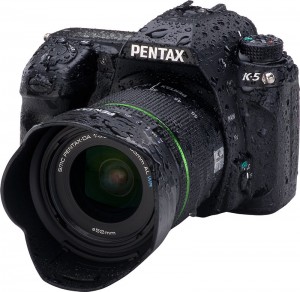 This 16 megapixel weatherproof camera is now my mainstay for “serious” photography and I think it’s a classic. The dynamic range and low low capabilities are as good as you can get in 2011 for an APS-C sized sensor. Combined with good quality optics, the K-5 produces excellent images up to ISO 3200 before noise is an issue. In fact with minimal noise processing, the K-5 delivers good images at 6400 ISO. Now that’s great for low light photography and even astrophotography. My K-5 is a relatively new purchase and I am yet to fully exploit it.
This 16 megapixel weatherproof camera is now my mainstay for “serious” photography and I think it’s a classic. The dynamic range and low low capabilities are as good as you can get in 2011 for an APS-C sized sensor. Combined with good quality optics, the K-5 produces excellent images up to ISO 3200 before noise is an issue. In fact with minimal noise processing, the K-5 delivers good images at 6400 ISO. Now that’s great for low light photography and even astrophotography. My K-5 is a relatively new purchase and I am yet to fully exploit it.
However, I did not get into Pentax DSLR’s intentionally.
My journey into Pentax DSLR’s started when I got some free film-era Pentax glass and a K-1000 35mm SLR, so I thought it would be nice to find a use for these lenses. Another reason I got into Pentax was because of the high cost of an ultra-wide lens for my Olympus E-3. It was cheaper to get a new Pentax KX DSLR and a Tamron 10-24mm than a Zuiko 9-18mm. Since the Olympus 4/3rds system was on its way out, I wanted a platform with a future and access to legacy lenses.
By 2011, the Pentax DSLR line had a reputation for outstanding low-light capabilities up to ISO 3200, that’s something where my Olympus E-3 failed miserably. The modest Pentax KX succeeded where the E-3 failed, but the KX lacked some features I wanted, so I quickly returned and exchanged it for a Pentax KR, which proved to be a fine camera. Clearly, there was something good about this system and I can still use film era K-mount lenses with full aperture automation. This opens up a world of possibilities, not to mention inexpensive used lenses.
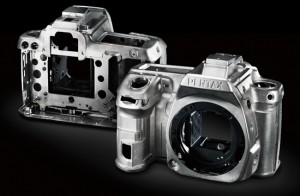 When the K-5’s price dropped by $600, I pounced on that sale to trade in my Pentax KR. The K-5 is a far more solid camera with a professional range of features. It has a weatherproofed magnesium alloy body that can take just about anything mother nature throws at it. A useful feature on this camera is in-body image stabilization (shake reduction). I like knowing that any lens I attach to it will be stabilized and that includes old film era lenses. Since many of my travels are done on a motorcycle, I do not want to lug around a tripod, so a built in stabilizer allows for sharper hand held shots.
When the K-5’s price dropped by $600, I pounced on that sale to trade in my Pentax KR. The K-5 is a far more solid camera with a professional range of features. It has a weatherproofed magnesium alloy body that can take just about anything mother nature throws at it. A useful feature on this camera is in-body image stabilization (shake reduction). I like knowing that any lens I attach to it will be stabilized and that includes old film era lenses. Since many of my travels are done on a motorcycle, I do not want to lug around a tripod, so a built in stabilizer allows for sharper hand held shots.
The K-5 also has a very well thought out control system that works well with my stubby fingers. A good camera must match you and the way you shoot. This is highly subjective criteria, but it becomes your reality when you start taking hundreds of photos. The K-5 just works for me.
The K-5’s RAW mode can generate Digital Negative Files (DNG) right from the camera. This is wise decision by Pentax as the K-5 is not reliant on proprietary RAW converters because DNG is an open format proposed by Adobe and may have a future.
One of the shortcomings of Pentax auto focus lenses is that they seem to suffer from front or back focus issues. I think this a real problem and it’s something Pentax should fix. All is not bad news though, the K-5 has a good work around. It can memorize auto focus fine tuning settings for up to 20 lenses. The pain here is that you must manually calibrate each auto focus lens using a 45 degree focus chart. After you’ve gone through this tedious process, you can be assured of very precise auto focus. The K-5 automatically knows when lens it is using and applies your setting. This feature is not unique to the K-5, but it’s necessary to ensure consistent focus.
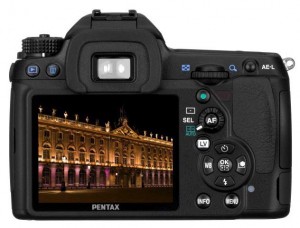 Using legacy manual focus K-mount glass works quite well on the K-5. If the vintage lens supports automatic aperture, that means it will work with all of the K-5’s metering and shooting modes. This is something Canon and Olympus can’t do. Manual focusing is not so bad since the K-5’s focus detector will beep when the lens is racked into focus. Very precise focus can be achieved using the camera’s live view mode on the superb LCD screen at 5x magnification. In the film days, Pentax produced some outstanding prime optics, many of which can now be had for a very modest price.
Using legacy manual focus K-mount glass works quite well on the K-5. If the vintage lens supports automatic aperture, that means it will work with all of the K-5’s metering and shooting modes. This is something Canon and Olympus can’t do. Manual focusing is not so bad since the K-5’s focus detector will beep when the lens is racked into focus. Very precise focus can be achieved using the camera’s live view mode on the superb LCD screen at 5x magnification. In the film days, Pentax produced some outstanding prime optics, many of which can now be had for a very modest price.
One area that I find somewhat lacking with the K-5 is the JPG engine. It’s actually quite good, but not always to my liking. So, I prefer to shoot RAW with the K-5 as it can produce RAW files in Adobe’s DNG format. Those RAW files work very well in Adobe Lightroom and when I apply a custom color profile created with the X-Rite ColorChecker passport, I am very pleased indeed. There is tons of latitude in the K-5’s RAW files, so as software improves, so will the K-5’s images.
If there’s one criticism I can apply to this camera, it’s the lack of an articulating view screen. Canon, Nikon and Sony feature this on a number of their DSLRs, so why did Pentax opt out? Having such a screen can be invaluable for some macro work or other shots you need to compose at odd angles.
For a nearly professional quality camera, the K-5 is actually decent sized without being too large. It has some heft to it, but just enough to counterbalance some large lenses that could be attached to it. It’s rugged enough and small enough to be a good system to take on long motorcycle rides or travel abroad. From my limited use with this camera, I am very impressed with its image quality.
Olympus Pen E-P3 Micro 4/3 Mirrorless Interchangeable Lens Camera
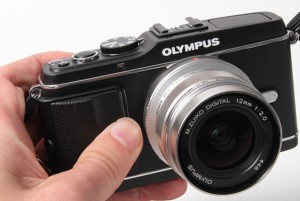 A little jewel that I take with me when I don’t want to lug around a big DSLR and heavy lenses. Unlike my DSLR cameras, I prefer to use the JPG engine in the E-P3 instead of shooting RAW. IMHO, the Olympus Pen cameras produce the best “out of the box” JPGs. The only reason to shoot RAW is to have a backup to the JPG if you want to try out some other processing effects. The E-P3’s JPG engine seems to squeeze out the best from its sensor.
A little jewel that I take with me when I don’t want to lug around a big DSLR and heavy lenses. Unlike my DSLR cameras, I prefer to use the JPG engine in the E-P3 instead of shooting RAW. IMHO, the Olympus Pen cameras produce the best “out of the box” JPGs. The only reason to shoot RAW is to have a backup to the JPG if you want to try out some other processing effects. The E-P3’s JPG engine seems to squeeze out the best from its sensor.
I got into the Olympus Pen series thanks to alcohol. Originally I wanted a portable camera that would produce better image quality than a typical point and shoot. So, I purchased a Canon S-90 that fit the bill. Image quality from that Canon was better than a typical point and shoot, but still nowhere near the quality of a DSLR. Nonethless, this little Canon did the job until one night it died. Some friends and I were partying up north in Haliburton, Ontario and I took the S-90 with me on a visit to a hunting lodge. I had a nice glow on and like an idiot I dropped the camera and ruined it. It fell just over a meter and was dead! The lens barrel was busted and could no longer retract, so time for a new camera as the cost of fixing this would be high.
Thanks to an expensive party, the hunt was on for a new camera. There was a sale on the Olympus E-PL1, which priced it about the same as replacing the Canon S-90. The E-PL1 is a larger camera, but could produce superior images to the S-90 and it had interchangeable lenses. Nontheless, it was still much smaller than a true DSLR. After using the E-PL1 for a year, I was convinced that mirrorless interchangeable lens cameras and the Pen series were good, really good. The JPG engine blew me away and the E-PL1 produced near DSLR quality photos. Besides, it was just plain fun to use the Pen.
I traded in my E-PL1 for a brand new Olympus E-P3. This is like upgrading from a bare bones Honda Civic to a loaded Lexus. The E-P3 is a well made machine that exudes quality. Not only did I gain much better controls on the camera body, it’s more solid and has a beautiful OLED touch screen. One sore point with the old Pen cameras was sluggish auto focus. The E-P3 solved this problem, it focuses as fast as a DSLR in good light. So, I can rely on the speed and accuracy of this camera in most situations. In true Olympus form, the camera meters well and gets the correct white balance. The E-P3 features decent built-in image stabilization (shake reduction) and that means any lens put on it is automatically stabilized.
At first, the E-P3 did not produce the same quality JPG’s as the E-PL1! How can this be? A camera that costs more than twice as much is not delivering the goods. The JPG’s seemed kind of mushy and fine details were smudged, even at ISO 200. When I examined the RAW files, the fine details were present and very clear too. As it turns out, the problem is the default noise reduction is far too aggressive. The solution was simple, change it from “standard” to “low”. After that tweak, the E-P3 produces very detailed images with better dynamic range and noise control than then E-PL1. Without more post processing, I feel comfortable using the E-P3 up to ISO 1600. The difference in image quality between the basic E-PL1 and the luxury E-P3 were not that dramatic. However, that’s not a bad thing as the E-PL1 produced great images.
One of the strengths of the Pen series, or any micro 4/3 camera, is they can use film era lenses from just about any manufacturer through inexpensive adapters. By discarding the reflex mirror, the lens barrel can be closer to the sensor and this means a whole slew of lenses can reach focus just be varying the length of an adapter tube. Lenses designed specifically for micro 4/3 are about half the size and weight of their DSLR counterparts, moreover they feature excellent optics. This is same advantage Leica range finder aficionados enjoyed in the days of 35mm film. It is possible to use virtually any film era lens from a 35mm camera on a micro 4/3 camera with the appropriate adapter. This opens up a whole world of creative possibilities.
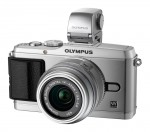 Sometimes it’s not desirable to use the LCD screen to compose and focus an image. The Olympus Pen series feature detachable electronic viewfinders. I think this is a great compromise between portability and functionality. I use the Olympus Olympus VF-3 electronic viewfinder when eye level composition and focusing is required. It is an articulated viewfinder that can be tilted up a full 90 degrees. It attaches to the camera’s hot shoe and is very pocket friendly. It is not the highest resolution electronic viewfinder on the market, but it does the trick.
Sometimes it’s not desirable to use the LCD screen to compose and focus an image. The Olympus Pen series feature detachable electronic viewfinders. I think this is a great compromise between portability and functionality. I use the Olympus Olympus VF-3 electronic viewfinder when eye level composition and focusing is required. It is an articulated viewfinder that can be tilted up a full 90 degrees. It attaches to the camera’s hot shoe and is very pocket friendly. It is not the highest resolution electronic viewfinder on the market, but it does the trick.
 When first considered, the E-P3’s touchscreen may seem like a gimmick, but it’s proven to be much more than that. In fact, it has challenged my notion of using a shutter button to take a photo. The E-P3 has a whopping 35 separate focus points, all of which can be accessed from the touch screen. Instead of using cumbersome dials or buttons to select a focus point, you just touch the screen where you want the camera to focus and it takes a photo. Simple and effective. Using the touch screen to snap a photo is not quite as fast as using the shutter button, but it’s still fast enough thanks to the E-P3’s quick focusing.
When first considered, the E-P3’s touchscreen may seem like a gimmick, but it’s proven to be much more than that. In fact, it has challenged my notion of using a shutter button to take a photo. The E-P3 has a whopping 35 separate focus points, all of which can be accessed from the touch screen. Instead of using cumbersome dials or buttons to select a focus point, you just touch the screen where you want the camera to focus and it takes a photo. Simple and effective. Using the touch screen to snap a photo is not quite as fast as using the shutter button, but it’s still fast enough thanks to the E-P3’s quick focusing.
Another feature that I thought was kind of a gimmick at first were the “art” filters. The E-P3 can create the following effects: pop art, soft focus, pale light and color, grainy film, pin hole, light tone, diorama, cross process, gentle sepia and dramatic tone. I actually like both the grainy film and dramatic tone filters. The former emulates the effect of push processed high ISO black and white film, which can be desirable at times. The dramatic tone filter can ad impact to some shots. The other filters are not really my cup of tea as they seem just too phony or can be reproduced in Lightroom or Photoshop with ease.
All things considered, the E-P3 is a very well built advanced camera that can be customized to make it work your way. The image quality is almost on par with many DSLRs using an APS-C sized sensor. Lenses for this system are remarkably small and light and also of good quality. The E-P3 is something you can pocket in a coat and still have room for another lens or two in your other pocket.
Olympus E-3 DSLR
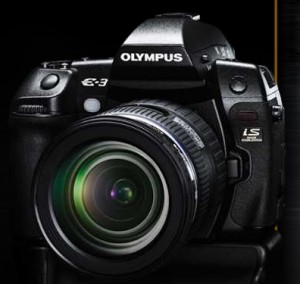 I am still using this virtually indestructible 10 megapixel DSLR that was released in 2007. The main reason I continue using the E-3 is because the Zuiko lenses I have for it are nothing short of amazing. Sure, this system is getting a bit long in the tooth and is now obsolete, but it can still produce some spectacular images if you shoot below ISO 1000. It really goes to show you that often times excellent lenses count for more than the camera. In their price range, high grade Zuiko glass is virtually unmatched. Many technical reviews can substantiate this claim.
I am still using this virtually indestructible 10 megapixel DSLR that was released in 2007. The main reason I continue using the E-3 is because the Zuiko lenses I have for it are nothing short of amazing. Sure, this system is getting a bit long in the tooth and is now obsolete, but it can still produce some spectacular images if you shoot below ISO 1000. It really goes to show you that often times excellent lenses count for more than the camera. In their price range, high grade Zuiko glass is virtually unmatched. Many technical reviews can substantiate this claim.
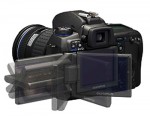 The E-3 is a heavy and large camera, more so than most DSLR’s without a “professional” designation. The E-3 was released as a professional camera and compared to professional (top of the line) offerings from Nikon and Canon, the E-3 was actually smaller and lighter, not to mention significantly cheaper. It offered full weatherproofing and a solid magnesium alloy body. Actually, I prefer a somewhat larger and heavier camera as it fits my fat fingers better. Another feature that made the E-3 stand out was built in image stabilization and an articulating view screen.
The E-3 is a heavy and large camera, more so than most DSLR’s without a “professional” designation. The E-3 was released as a professional camera and compared to professional (top of the line) offerings from Nikon and Canon, the E-3 was actually smaller and lighter, not to mention significantly cheaper. It offered full weatherproofing and a solid magnesium alloy body. Actually, I prefer a somewhat larger and heavier camera as it fits my fat fingers better. Another feature that made the E-3 stand out was built in image stabilization and an articulating view screen.
The image sensor on top of the line Canon and Nikon offerings back in 2007 were better than the E-3. Then again I was looking for a full system that would not cost me several thousand dollars to get a good camera with two or three outstanding lenses. When one compared the sensor quality of the E-3 to similarly priced offerings from Canon and Nikon, one was splitting hairs.
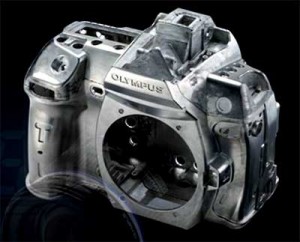 I can attest to the durability of the E-3. A few years ago I suffered a motorcycle accident when someone blew through a stop sign. As a result the camera flew off the bike and landed several meters away without any damage. It was inside a camera bag, but the accident destroyed the bag and the E-3 was none the worse for wear and the Zuiko lenses were intact. The bike was destroyed, I was busted up, but that tank-like E-3 was intact.
I can attest to the durability of the E-3. A few years ago I suffered a motorcycle accident when someone blew through a stop sign. As a result the camera flew off the bike and landed several meters away without any damage. It was inside a camera bag, but the accident destroyed the bag and the E-3 was none the worse for wear and the Zuiko lenses were intact. The bike was destroyed, I was busted up, but that tank-like E-3 was intact.
One of the benefits of a 4/3 camera system, like the E-3, is it is more compact that APS-C camera systems with similar lenses. My two favourite lenses are excellent Zuiko 12-60mm f/2.8 zoom and the Zuiko 50-200mm f/2.8 telephoto. Similar f/2.8 lenses for an APS-C sized sensor would actually be larger and more expensive. Since the E-3 has a decent image stabilizer built into the body, all the lenses I use on it are stabilized. Canon and Nikon require you to buy lenses with their own stabilizers and that adds to the cost and weight. So, for motorcycle trips, the E-3 with two high grade lenses travels well and can fit into a saddlebag.
When the E-3 was released, Olympus claimed it had the world’s fastest autofocus system provided you use their SWD lenses. That claim may or not be true. However, I will say that compared the other cameras I’ve owned, it’s very fast and nails the focus almost every time. Olympus lenses have upgradeable firmware and I suspect that may explain why they work so well. They are in essence “smart” lenses.
There is something very subjective I like about this camera: it’s the way Olympus renders its colours. I normally shoot in RAW format and will either use Olympus’ Viewer software or Adobe Lightroom to render the RAW files. I find I can get the “Olympus” colours by using the X-Rite ColorChecker passport to create profiles use by Lightroom. Furthermore, as RAW processing software improves, the E-3 continues to have a lease on its lifespan.
One thing that gets overlooked with many digital cameras is how well they calculate auto white balance. The E-3 succeeds very well since it has a dedicated white balance sensor on the camera body. Another strength of this camera is very reliable and accurate metering. Most of the shots taken with the E-3 are well exposed with proper light balance. These features are not emphasized in technical reviews, but believe me, it makes a difference when you are shooting.
These days I plan to use the E-3 mostly for birding and long distance nature shots as well as macro photography. My Zuiko 50-200mm SWD is a great lens for shots of birds and animals. The superb Zuiko 50mm f/2.0 macro still remains one of the best lenses in its class ever built. The camera will also be used during extremes of weather or rain, heat and cold. Two of my Zuiko lenses are weatherproofed and combined with the E-3, they can take just about any weather thrown at them. If it were not for the outstanding quality of high grade Zuiko glass I purchased for the E-3, I would have sold this camera by now.
Lenses Used
Olympus Zuiko 12-60 f/2.8 SWD
Olympus Zuiko 50-200 f/2.8 SWD
Olympus Zuiko 50mm f/2.0 macro
Olympus Zuiko 35mm f/3.5 macro
Olympus Zuiko m14-42mm II R f/3.5-5.6 (Kit lens with Olympus E-P3)
Panasonic Lumix G 20mm f/1.7 ASPH
Olympus M. Zuiko Digital ED 45mm f/1.8
Sigma 18-50mm f/2.8 EX DC (Pentax mount)
Pentax SMC DA 35mm f/2.4 AL
Tamron AF 10-24mm F/3.5-4.5 SP Di II (Pentax mount)
SMC Pentax-M 50mm f/1.7
Cosmicar 50-200mm f3.5 zoom
